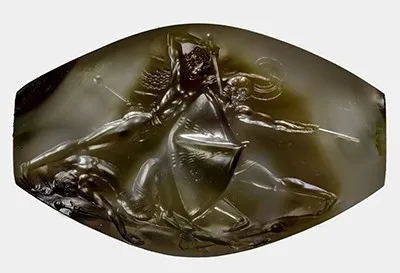Masterpiece of Greek Art Found in the Griffin Warrior Tomb
The engraving on the Pylos Combat Agate is so tiny and intricate that it changes our understanding of what the ancient Greeks could produce
/https://tf-cmsv2-smithsonianmag-media.s3.amazonaws.com/filer/d4/5e/d45e3888-f4c6-4613-91ae-e72e4c353c5c/combate_agate_illo.jpg)
In 2015, archaeologists discovered an intact tomb of a Mycenean warrior or priest later dubbed the “Griffin Warrior” in an olive grove near Pylos, Greece, dating to around 1450 B.C. It was an incredible find, with the researchers recovering gold and silver cups, weapons and armor, and 50 gold and gemstone seals engraved with intricate images. Now, reports Nicholas Wade at The New York Times, researchers have fully analyzed one of those agate seals and have found that it is on par with the greatest artworks of the ancient world.
But unlike ancient Greek sculpture or Roman mosaics, the seal might be hard to see without a magnifying glass. The engraved image is less than an inch and a half long, but includes an incredibly detailed scene of a warrior slaying two enemies. The seal has been named the Pylos Combat Agate.
“The stunning combat scene on the seal stone, one of the greatest masterpieces of Aegean art, bears comparison with some of the drawings in the Michelangelo show now at the Metropolitan Museum of Art,” Malcolm H. Wiener, an expert on Aegean prehistory and a trustee emeritus of the Metropolitan Museum, tells Wade.
According to a press release, when archaeologists from the University of Cincinnati first found the agate, which was encrusted with dirt and grime, they did not recognizes its significance. It wasn’t until they began removing the layer of limestone on the agate that they saw the intricate image. “Looking at the image for the first time was a very moving experience, and it still is,” says Shari Stocker, one of the dig leaders and a research associate in University of Cincinnati's department of classics. "It's brought some people to tears."
How the stone was carved is something of a mystery. Some details are only half-a-millimeter in size and would have required the use of some sort of magnifying device to get the elements right. However, no such equipment has been found in the ancient Greek world, Wade of the Times reports.

The sealstone was likely designed to be mounted on a band and worn on the wrist. In fact, the victorious warrior on the stone is depicted wearing his own seal stone. For those wondering if the warrior image is from some early version of Greek epics like the Iliad or the Odyssey, the researchers say there is no real way to connect the two, especially since Homer’s works were written down around 700 B.C. It’s possible that the oral tradition behind the works stretches back to the time of the Griffin Warrior, but there is no evidence.
What the intricate seal does do, however, is build on what scholars know about the relationship between the ancient Mycenaeans, who lived mostly on the Peloponnese Peninsula on mainland Greece, and the Minoans, a culture that lived on Crete and likely created the Pylos Combat Agate. The Minoans were like the ancient Greeks of the ancient Greek world—they were miles ahead of other cultures in the region and developed sophisticated concepts of art, architecture, religion and thought that would heavily influence the rest of the Greek world. While archaeologists believed the Mycenaeans plundered the Minoans, absorbing many of their cultural ideas, the Griffin Warrior has challenged some of those assumptions, showing that there was an exchange of ideas between the Mycenaeans and Minoans, and that the mainlanders respected Minoan culture and used their iconography and art—like the Pylos Combat Agate—as symbols of political power.
The agate also shows just how advanced the Minoans were. “It seems that the Minoans were producing art of the sort that no one ever imagined they were capable of producing,” Jack Davis, head of the University of Cincinnati’s archaeology department, says in the press release. “It shows that their ability and interest in representational art, particularly movement and human anatomy, is beyond what it was imagined to be. Combined with the stylized features, that itself is just extraordinary.”
The Pylos agate may not be the only treasure from the tomb to rewrite early Greek history, either. The archaeologists have catalogued 3,000 objects from the tomb, many of which have not yet been cleaned or restored.